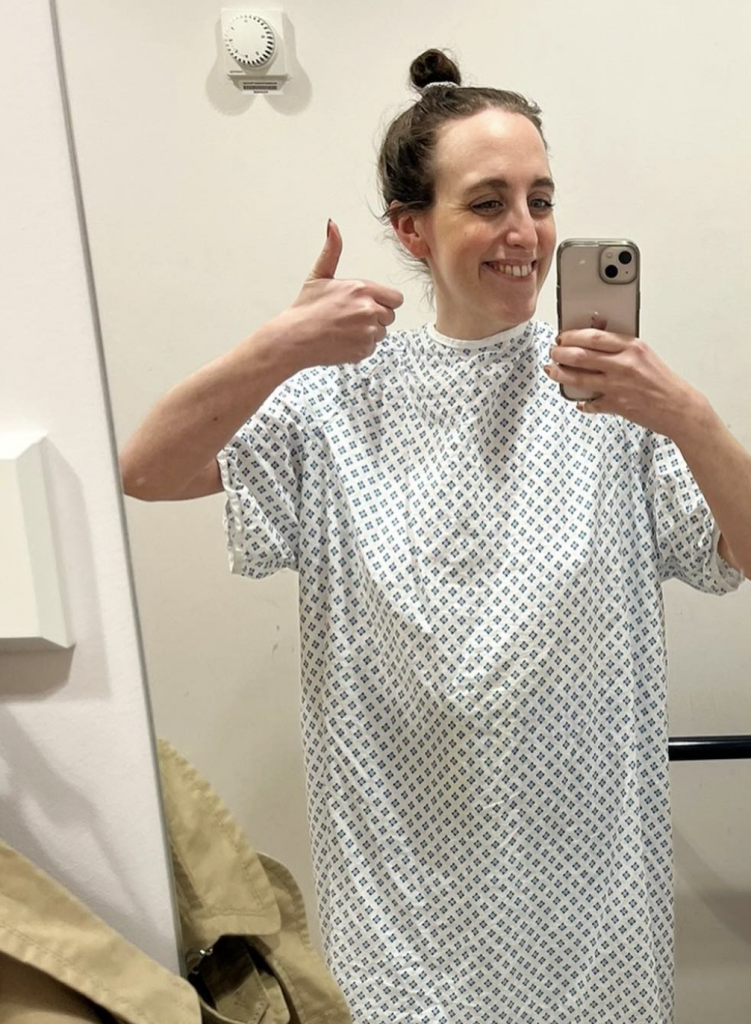Getting Immediate Care
- Ellie Willcock, 25, assumed her stomach pain was caused by a urinary tract infection, but when it continued to linger, she underwent multiple tests and soon found out it was stage four colorectal cancer.
- Colorectal cancer, which is called bowel cancer in the United Kingdom where Willcock is from, is a disease where cells in the rectum or colon grow out of control.
- While experts don’t know exactly what causes colon cancer, they do point to certain risk factors, such as diet, smoking tobacco, and drinking alcohol. Having a family history of colorectal cancer can also increase the risk.
- While Willcock experienced abdominal pain, it’s important to know that colorectal cancer may not cause symptoms at all. However, other presenting symptoms can include: a change in bowel habits, fatigue, and unintended weight loss. Be sure to see your doctor if any of these symptoms persist, and also discuss screening for the disease.
Colorectal cancer, which is called bowel cancer in the United Kingdom where Willcock is from, is a disease where cells in the rectum or colon grow out of control.
Read MoreThankfully, after surgery and “grueling chemotherapy,” Willcock was told she had no evidence of disease present.

‘You Really Can Live with Cancer’
While going through cancer, Willcock said she felt inspired by the late socialite and beloved BBC host Dame Deborah James, who worked tirelessly to raise awareness for the disease during her fight, and raised millions of dollars, while remaining positive through the end.
“It was Deborah that made all of this ‘new world’ feel human. Deborah, to me, was proof that you really can live with cancer. She was this beacon of hope who was truly empowering and inspiring.”

“This positivity continues to shine with her legacy,” Willcock added of the late You, Me, and the Big C host.
Colorectal cancer is the third most common cancer in the UK, and the diagnosis keeps affecting younger and younger people, which is why these stories matter so much, to raise awareness, and get people in to get checked.
Learning More About Colorectal Cancer
Colorectal cancer, or colon cancer, affects your large intestine (colon) or the end of your intestine (rectum).
Though Willcock experienced abdominal pain, it’s important to know that colorectal cancer may not cause symptoms at all. However, other presenting symptoms can include:
- A change in bowel habits (eg. constipation, diarrhea, narrow stool) that persists
- Abdominal cramping or pain
- Weakness or fatigue
- Unintended weight loss
Any of these lingering symptoms should be reported to your doctor as soon as possible.
The cancer starts when abnormal lumps called polyps grow in the colon or rectum. If you don’t have these polyps removed, they can sometimes turn into cancer. It takes up to 10 years for a colon polyp to become full-blown cancer, so if you get the recommended screenings, then your doctor will have time to remove any polyps that form before they can cause problems.
SurvivorNet medical advisor Dr. Heather Yeo, a colorectal surgeon at Weill Cornell in New York, recommends that people at average risk of colon cancer start regular screening at age 45.
“Colon cancer is considered a silent and deadly killer, Dr. Yeo explained. “What happens is people often don’t know that they have colon cancer. They don’t have any symptoms. That’s why we screen for colon cancer in the United States.”
Dr. Yeo says that you should be screened for colon cancer, even if you have no family history. A colonoscopy is the method of screening for this type of cancer.
Understanding the Function of the Colon and the Rectum
“Once you have your initial screening colonoscopy, if there are no polyps and you have no high risk factors, usually once every 10 years is fine,” Dr. Yeo said.
Dr. Paul Oberstein, a medical oncologist at the NYU Perlmutter Cancer Center, told SurvivorNet, “One of the most important facts about colon cancer is that the earlier and smaller it’s detected, the easier the treatment is and the more likely it is to be cured.”
Colon Cancer: Key Terms to Know
While experts don’t know exactly what causes colon cancer, they do point to certain risk factors, such as diet, smoking tobacco, and drinking alcohol. Having a family history of colorectal cancer can also increase the risk.
In order to better understand the disease, we’ve put together a list of colon-cancer-related terms to help you or a loved one should a diagnosis arise.
Abdominoperineal resection (APR): is a surgery in which the anus, rectum and sigmoid colon are removed. This procedure is most often used to treat rectal cancers located very low in the rectum. Patients who undergo APR will have a non-reversal colostomy performed.
Adenocarcinoma: is the most colon cancer subtype. It’s a cancer that starts in mucus-producing (glandular) cells of your colon.
Anastomosis: refers to a connection between two tubes or passages that would normally branch away from each other. Anastomosis is when surgeons connect two tube-like structures (colon) inside the body.
Anastomotic leakage: occurs when a surgical anastomosis fails and contents of a reconnected body channel leak from the surgical connection. It’s one of the most serious complications of bowel resection surgery.

Biomarker: is molecular pattern that can help with cancer diagnosis, prognosis, and management. The biomarkers most used in colon cancer management are genetic mutations within the tumor, such as MMR/MSI, KRAS, BRAF, and HER2 and bloodstream carcinoembryonic antigen (CEA).
BRAF Mutation: BRAF gene mutation happens randomly and it’s not hereditary. It’s found in about 10% of colorectal cancer patients. And knowing about a BRAF gene mutation indicates the need for aggressive treatment, since the mortality risk for patients with a BRAF mutation is more than two times higher than for those with a normal BRAF gene.
Bloodstream carcinoembryonic antigen (CEA): Is a protein that is produced by most tumor cells (but not all) and can be picked up in the bloodstream. High CEA levels do not establish a colon cancer diagnosis. However, higher CEA levels correlate with a worse prognosis and potential metastasis.
Carcinoma in situ: refers to cancer in which abnormal cells have not spread beyond where they first formed. These are cancers are at a very initial stage and are more likely to be cured.
Colectomy: A colectomy is an operation to remove part or all of your colon. You can hear some variations of the word, depending on what part of the colon if removed:
- Hemicolectomy
- Ileocolectomy
- Left colectomy
- Low anterior resection (LAR) see below
- Right colectomy
- Sigmoidectomy
Colonoscopy: is the endoscopic examination of the large bowel (colon) with fiber optic camera on a flexible tube passed through the anus. It can provide a visual diagnosis and grants the opportunity for biopsy or removal of suspected cancer lesions.
Colostomy: A colostomy or ileostomy means that part of your intestines are hooked up through the front of your belly, and you go to the bathroom through a bag that attaches to your skin. When the large intestine (colon) is brought through this opening in the skin it’s called a colostomy. Whereas an ileostomy is when a part of the small intestine (ileum) is attached to the skin.
Endoscopic mucosal resection: is procedure to remove precancerous, early-stage cancer or other abnormal tissues (lesions) from the digestive tract. It’s minimally invasive procedure that can sometimes be performed for early staged lesion.
Familial adenomatous polyposis (FAP): it’s a type of hereditary colon cancer. People with FAP have hundreds, or even thousands, of polyps that coat the inside of their colon. Because of this, without treatment, all patients with FAP will go on to develop colon cancer
FOLFIRI: It’s a chemotherapy regimen that includes the drugs leucovorin calcium (folinic acid), fluorouracil, and irinotecan hydrochloride.
FOLFOX: Is an abbreviation for a combination chemotherapy regimen that is used to treat colorectal cancer. It includes the drugs leucovorin calcium (folinic acid), fluorouracil, and oxaliplatin.
HER2 Biomarker: the human epidermal growth factor receptor 2 (HER2) is a receptor on the surface of almost all the cells in our body, and it is responsible for the communication between the cells to promote their growth, division, repair, and survival. Approximately 3% of colorectal cancers have amplification of the HER2 oncogene. This mutation is not hereditary and will not pass from one generation to another.
Ileostomy: that means that part of your small intestines (ileum) is hooked up through the front of your belly, and you go to the bathroom through a bag that attaches to your skin.
KRAS and NRAS: these are some of the biomarkers (molecular pattern) that can help with cancer diagnosis, prognosis, and management. Approximately 40% of colorectal cancer patients have KRAS mutation in their tumors. This mutation is not hereditary and will not be passed from one generation to another it’s completely random.
Laparoscopic surgery: Laparoscopic or “minimally invasive” surgery is a specialized technique for performing surgery. This system allows surgeons to perform the same operations as traditional surgery but with smaller incisions. At the beginning of the procedure, the abdomen is inflated with carbon dioxide gas to provide a working and viewing space for the surgeon. The laparoscope transmits images from the abdominal cavity to high-resolution video monitors in the operating room. Patients often experience less pain, a shorter recovery, and less scarring with laparoscopic surgery.
WATCH: Dr. Paul Oberstein explains why it sometimes makes sense to give chemotherapy before colon cancer surgery.
Low anterior resection (LAR): is performed to treat cancer of the rectum (the lowest part of the large bowel) when the cancer does not involve the anal sphincter muscles. It usually removes the distal part of the sigmoid colon and the rectum.
Lynch Syndrome, or Hereditary (Non-Polyposis) Colon Cancer: Although most colon cancer affects people with no family history or genetic predisposition to it, a small amount of people do suffer from hereditary colon cancer. It’s estimated that Lynch syndrome is responsible for 3% of all colorectal cancers.
Metastasis: The spread of cancer cells from the place where they first formed to another part of the body. The cancer cells can travel through the blood or lymph system, and form a new tumor in other organs or tissues of the body.
Microsatellite Instability (MSI-High): the accumulation of errors in your DNA due to mutation of mismatch repair (MMR) genes is known as High Microsatellite Instability (MSI-H). Determining if you have has this mutation could affect what treatment you are ultimately given.
Non-Invasive: The tumors can be found in the top layer of cells and are confined to the colon, these are cancers are at a very initial stage and are more likely to be cured.
Polyp: is a small growth in the colon that is not yet cancerous, but has the potential to grow into cancer. For a typical polyp to grow into colon cancer, it takes about ten years.
Looking for Polyps During a Colonoscopy
Polypectomy: is the surgical removal of a polyp. Most of the times it is performed during a colonoscopy.
Rectum: Is the final part of the colon; it is about 6 inches long, and its main function is to store stool until a bowel movement can be made.
Risk Factors: Risk factors, in general, are factors that can make you more likely to develop a specific disease. Risk factors for colorectal cancer include smoking, obesity, age (the risk of colon cancer increases as you age) and personal history (your risk increases if you or anyone in your family has had colorectal cancer).
Sections of the colon: the colon is divided into four different sections. They work together to absorb water and other nutrients from the waste material to prepare for excretion.
- Ascending colon, which absorbs the remaining water and other nutrients from the indigestible food material, solidifying it into stool
- Transverse colon is the longest and most movable part of the colon. It absorbs water and salts from the indigestible material.
Descending colon, which is a storage area for feces - Sigmoid colon: is where most of colorectal lesion appear. It’s a part of the large intestine that is closest to the rectum and anus and has an S-shape.
Systemic Therapy: Treatments that affect the whole body. The most common form of systemic therapy is chemotherapy, but targeted therapy and immunotherapy are also options.
Here is SurvivorNet’s comprehensive guide to colon cancer for a full overview.
Learn more about SurvivorNet's rigorous medical review process.

